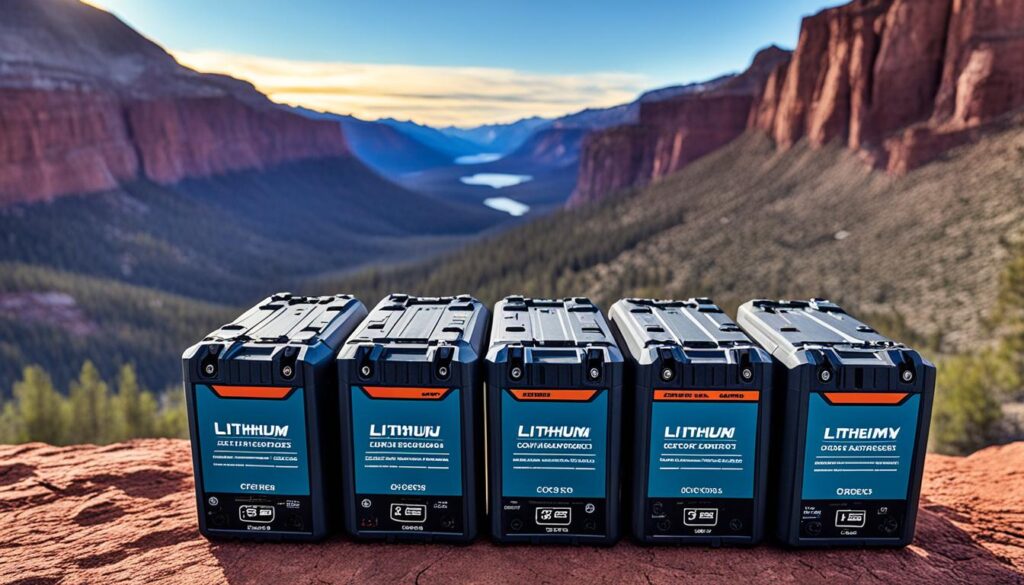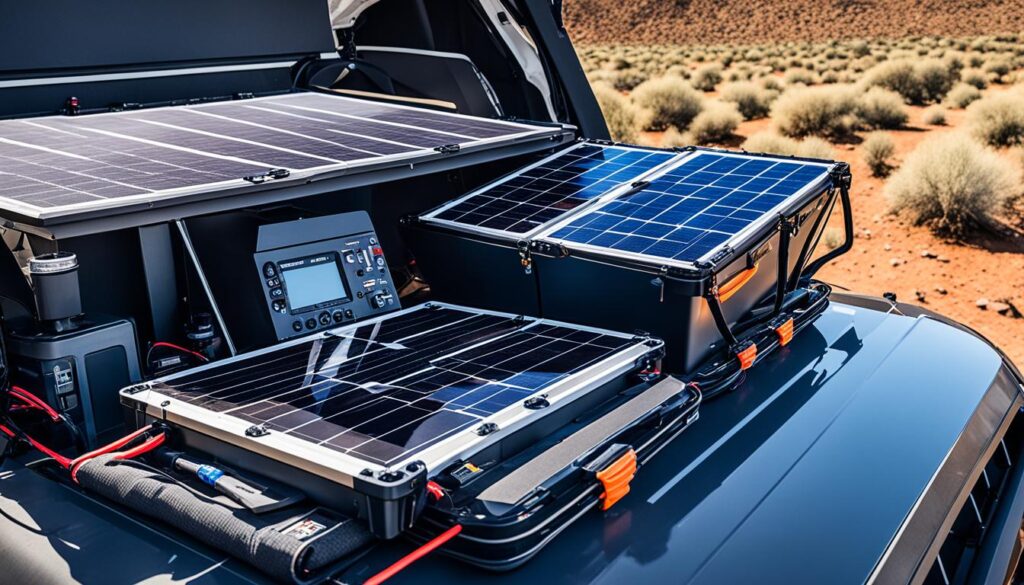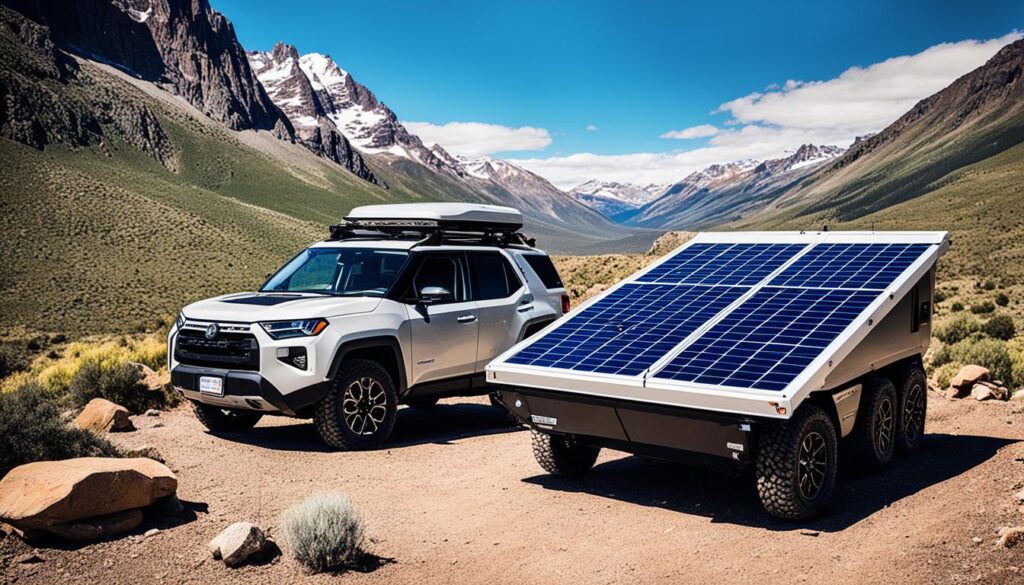When it comes to overlanding, one question that often comes to mind is: How can I safely store my solar batteries and ensure a reliable power source for my off-grid adventures?
Having a secure and efficient solar battery storage solution is crucial for any overlanding trip. It allows you to enjoy the convenience of power while immersing yourself in the beauty of nature. In this article, I will explore expert tips for safe solar battery storage for overlanding, including the best locations for placement and the considerations you need to keep in mind.
Key Takeaways:
- Proper solar battery storage is essential for a reliable power source during overlanding.
- Select lithium-ion batteries for their lightweight design and long lifespan.
- Consider the best location for solar battery placement, whether inside or outside your vehicle.
- Ensure easy accessibility to the batteries for maintenance or emergency situations.
- Customize your solar battery system to optimize performance and convenience.
Contents
Selecting the Best Solar Batteries for Overlanding
When it comes to overlanding, choosing the right solar batteries is key to ensuring a successful off-grid adventure. The best battery for overlanding is the lithium-ion battery, known for its exceptional performance and reliability. With their lightweight design and high energy density, lithium-ion batteries are the preferred choice for overlanders seeking efficient power solutions. Unlike traditional lead-acid batteries, lithium-ion batteries do not require venting and provide twice the power, allowing you to operate your camping essentials without worry.
Investing in lithium-ion batteries for overlanding offers several advantages. Not only do they save space and reduce weight in your vehicle, but they also have a longer lifespan, making them a cost-effective option in the long run. With a lifespan of up to 10+ years, these batteries provide durability and reliability for your overlanding journeys.
When determining the number of batteries you’ll need for your adventure, consider factors such as cost, weight constraints, and available space. An energy audit can help you estimate the watt-hours required and determine the appropriate battery bank size for your specific overlanding needs.
In summary, lithium-ion batteries are the best choice for overlanding due to their lightweight design, high energy density, lack of venting requirements, and longer lifespan. By selecting the right solar batteries, you’ll ensure a reliable power source that can withstand the demands of your off-grid adventures.
Advantages of Lithium-Ion Batteries for Overlanding
- Lightweight design
- High energy density
- No venting requirements
- Twice the power of standard lead-acid batteries
- Longer lifespan (10+ years)
| Advantages | Lithium-Ion Batteries | Lead-Acid Batteries |
|---|---|---|
| Weight | Lightweight | Heavy |
| Power | Twice the power | Standard power |
| Venting | No venting required | Requires venting |
| Lifespan | 10+ years | Shorter lifespan |
Table: A comparison of lithium-ion batteries and lead-acid batteries for overlanding.
With these advantages in mind, lithium-ion batteries are the ideal choice for overlanding enthusiasts looking for the best battery solution. Their lightweight design, higher power output, lack of venting requirements, and longer lifespan make them a reliable and efficient option for powering your overland adventures.

Finding the Perfect Spot for Solar Battery Placement
When it comes to overlanding, the placement of your solar batteries plays a crucial role in their safety and efficiency. There are several essential factors to consider when deciding where to put your solar batteries during your off-grid adventures.
Inside the Vehicle
If you prioritize safety and protection from external elements, installing your lithium-ion batteries inside your vehicle is a great option. Unlike other battery types, lithium-ion batteries do not require venting, making them safe for indoor use. This placement ensures that your batteries are secure and shielded from extreme weather conditions during your overlanding journey.
Outside the Vehicle
If you prefer storing your batteries outside, there are a couple of options to consider. You can mount them on a rack attached to your vehicle or place them in the bed of your overland truck. Mounting them on a rack provides easy access for maintenance and ensures proper ventilation. Placing them in the bed of your truck keeps them secure while taking advantage of the available space. Whichever option you choose, accessibility and protection should be your top priorities.
Weight Distribution and Stability
Proper weight distribution is essential for maintaining vehicle balance and stability during your overlanding trips. When placing your batteries, aim to keep them as low as possible to minimize the increase in the center of gravity, which can lead to stability issues, especially on rough roads. Distribute the weight evenly to ensure a safe and stable driving experience.
Wiring and Cable Sizing
Ensuring the safety and efficiency of your solar battery placement also involves proper wiring and cable sizing. Use high-quality cables that are appropriately sized to handle the current flow and minimize power loss. Securely connect and route the cables to prevent any potential damage or hazards. Taking the time to plan and execute the wiring and cable setup properly will ensure a safe and efficient solar battery system for your overlanding adventures.
| Placement Option | Advantages | Disadvantages |
|---|---|---|
| Inside the Vehicle | – Provides safety and protection – Allows for easy accessibility – Shields batteries from external elements | – May take up space inside the vehicle |
| Outside the Vehicle | – Utilizes available space – Allows for proper ventilation – Easy access for maintenance | – Requires additional mounting equipment – Exposed to external elements |
Charging Your Solar Batteries for Continuous Power
When it comes to overlanding, maintaining a continuous power supply is essential. Charging your solar batteries effectively ensures that you have the power you need for your off-grid adventures. In this section, we will explore different charging options and strategies to keep your batteries powered and ready for your overlanding journey.
Charging Options
There are multiple charging options available for overland travelers:
- Solar Panels: Harnessing the power of the sun is a popular choice for charging solar batteries. Solar panels can be mounted on your vehicle’s roof or placed on the ground near your camping area. Ensure that you have sufficient space for the panels and the necessary cabling. Consider using an MPPT (Maximum Power Point Tracking) charge controller for improved efficiency.
- Vehicle Alternator: Utilizing your vehicle’s alternator to charge your solar batteries is a convenient option during travel. However, it’s important to ensure that your alternator can handle the load and that your battery bank is properly wired to prevent any power surges.
- Shore Power: When available, shore power from generators or campsites can be used to recharge your solar batteries. This option provides a consistent and reliable power source, especially during extended stays at established campsites.
Charging Considerations
When charging your solar batteries for overlanding, keep the following considerations in mind:
- Battery Type: Lithium batteries, with their ability to accept higher power inputs, are a popular choice for overlanding. These batteries can be charged quickly and efficiently, reducing downtime and maximizing your time on the road.
- Backup Charging Plan: It’s essential to have a backup charging plan in case of limited sunlight or generator failure. This could include carrying a portable solar panel, a generator, or utilizing shore power at campsites. A backup plan ensures that you always have a reliable power source, regardless of the conditions.
- Battery Bank: Your battery bank serves as the heart of your power system. It’s crucial to choose a battery bank that can store enough energy to meet your power needs during your overlanding adventures. Consider factors such as capacity, voltage, and the ability to connect multiple batteries in parallel.
Having a comprehensive charging strategy for your solar batteries will enable you to power your essential devices and appliances during your overlanding trips, ensuring a comfortable and enjoyable off-grid experience.
| Charging Option | Pros | Cons |
|---|---|---|
| Solar Panels | Environmentally friendly | Dependent on sunlight availability |
| Vehicle Alternator | Convenient during travel | May strain the vehicle’s electrical system |
| Shore Power | Consistent power source | Dependent on availability at campsites |
Customizing Your Solar Battery System for Optimal Performance
When it comes to overlanding, a customized solar battery system is vital for optimal performance and convenience. By tailoring your setup to meet your specific needs, you can ensure a reliable power source that allows you to fully enjoy your off-grid adventures. To achieve the best results, consider the following factors:
- Additional Components: Enhance your solar battery system by incorporating additional components such as a battery cabinet. This cabinet provides easy access and protection for your batteries, ensuring their longevity. With the right storage solution, you can keep your batteries organized and secure during your travels.
- Space Maximization: Make the most of your available space by utilizing storage areas under the bed or rear doors for battery placement. By optimizing the space within your vehicle, you can create a streamlined setup that allows for efficient use of resources.
- High-Quality Batteries: Choose high-quality batteries like Battle Born Batteries, which are renowned for their lightweight design and exceptional lifespan. Investing in reliable and durable batteries ensures a long-term solution that will withstand the demands of off-grid exploration.
- Proper Planning and Installation: To ensure the safety and efficiency of your solar battery system, carefully plan and install the components. This includes selecting appropriate charge controllers, solar panels, and ensuring proper wiring. Seek the guidance of experts in the field to ensure a seamless installation process.
Take your time to understand the pros and cons of each option before finalizing your solar battery system. By customizing your setup, you can optimize its performance, making it an invaluable asset during your overlanding adventures.

| Component | Description |
|---|---|
| Solar Panels | Convert sunlight into electricity for recharging your batteries. |
| Battery Cabinet | Provides easy access and protection for your batteries. |
| Charge Controllers | Regulate the flow of electricity from the solar panels to the batteries. |
| Batteries | Store the generated electricity for later use. |
| Wiring | Connects all the components of your solar battery system. |
Conclusion
In conclusion, ensuring safe and optimal solar battery storage is essential for successful overlanding adventures. By carefully selecting the best solar batteries, strategically placing them, and customizing your system for efficient charging, you can guarantee a reliable power source throughout your off-grid journeys. Consider your specific overlanding needs and consult with experts to ensure you make informed choices.
With the right solar battery setup, you can enjoy the convenience of power while immersing yourself in nature’s beauty. You’ll have the freedom to explore remote locations, camp off-grid, and engage in outdoor activities without worrying about running out of power. Optimal solar battery storage and safe placement will give you peace of mind and keep your overlanding adventure running smoothly.
Remember, when it comes to overlanding, your power source is the lifeline of your journey. Investing in high-quality solar batteries, understanding their placement requirements, and customizing your system will pave the way for a seamless and enjoyable off-grid experience. Embrace the freedom and sustainability that solar battery storage brings, and embark on unforgettable overlanding expeditions.
FAQ
What are the advantages of using lithium-ion batteries for overlanding?
Lithium-ion batteries are recommended for overlanding due to their light weight, high energy density, and lack of venting requirements. They provide twice the power of standard lead-acid batteries while lasting up to 10+ years, making them a cost-effective option in the long run.
How do I determine how many solar batteries I need for my overlanding trip?
A thorough energy audit can help estimate the watt-hours you’ll need and determine the appropriate battery bank size for your overlanding adventure. Factors to consider include cost, weight, space limitations, and the power requirements of your appliances and electronics.
Where is the best place to install solar batteries in my overlanding vehicle?
You can install lithium-ion batteries inside your vehicle, as they do not require venting and provide a safe operating environment. Alternatively, you can mount them on a rack attached to the vehicle or in the bed of an overland truck. Ensure easy accessibility for maintenance and emergency situations, and consider weight distribution and center of gravity for vehicle balance and stability.
What are the options for charging solar batteries during overlanding?
You can charge your solar batteries using the vehicle’s alternator, solar panels, or shore power from generators or campsites. If you plan to use solar panels, ensure you have enough room for an MPPT and necessary cabling. Consider having an appropriate charger for fast and efficient charging, and have a backup plan in case of limited sunlight or generator failure.
How can I customize my solar battery system for optimal performance during overlanding?
Depending on your needs, you can customize your setup by adding components like a battery cabinet for easy access and protection, or utilizing storage areas under the bed or rear doors for battery placement. Careful planning and installation of components, such as charge controllers, solar panels, and wiring, are crucial for safety and efficiency.
Source Links
- https://battlebornbatteries.com/where-should-i-put-my-overland-battery-bank/
- https://overlandjournal.com/pages/portable-power-systems-the-best-off-grid-batteries-for-overland-travel-and-car-camping
- https://www.drivingline.com/articles/solar-101-the-ultimate-guide-to-off-road-and-overland-solar-setups/






